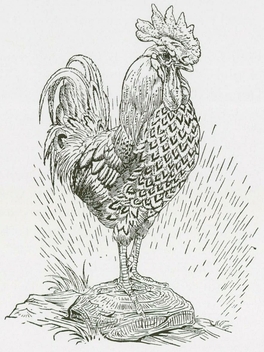LIST OF PLATES
FRONTISPIECE. The Crested Crane
From PICTURES FROM BIRDLAND, with rhymes by E.B.S.; illustrated by Maurice Detmold and Edward J. Detmold. [J. M. Dent & Co. London, and E. P. Dutton & Co. New York, 1899.]
The Green Tree Frog (on p. v of introduction)
From THE BOOK OF BABY PETS, descriptions by Florence E. Dugdale; illustrated by Edward J. Detmold. [Henry Frowde, Hodder and Stoughton, London, 1910.]
PICTURES FROM BIRDLAND, with rhymes by E.B.S.; illustrated by Maurice Detmold and Edward J. Detmold. [J. M. Dent & Co., London, and E. P. Dutton & Co., New York, 1899.]
- 1. The Toucan
- 2. The Gallinule
- 3. The Penguin
- 4. The Guan
- 5. The Ivory-Billed Woodpecker
- 6. The Osprey
- 7. The Hummingbird
- 8. The Cormorant
- 9. The Oriole
- 10. The Pheasant
- 11. The Hang Nest
- 12. The Bateleur Eagle
- 13. The Owl
THE JUNGLE BOOK by Rudyard Kipling; illustrated by Maurice Detmold and Edward J. Detmold. [Macmillan and Co., Limited, London, 1908.]
- 14. The “Council Rock”
- 15. “Akela” the Lone Wolf
- 16. Baloo in the Forest
- 17. The “Cold Lairs”
- 18. The Monkey Fight
- 19. “Kaa” the Python
- 20. Shere Khan in the Jungle
- 21. The Return of the Buffalo Herd
- 22. Rikki-tikki-tavi and Nag
- 23. Elephant-Dance
THE FABLES OF AESOP, illustrated by Edward J. Detmold. [Hodder and Stoughton, New York, 1909.]
- 24. The Hare and the Tortoise
- 25. The Oxen and the Axle-trees
- 26. The Monkeys and their Mother
- 27. The Vain Jackdaw
- 28. The Grasshopper and the Owl
- 29. The Lion and the Three Bulls
- 30. The Eagle and the Beetle
- 31. The Goat and the Ass
- 32. The Fox and the Crane
- 33. The Owl and the Birds
- 34. The She-Goats and their Beards
- 35. The Eagle and his Captor
THE BOOK OF BABY PETS, descriptions by Florence E. Dugdale; illustrated by Edward J. Detmold. [Henry Frowde, Hodder and Stoughton, London, 1910.]
- 36. Grey Squirrel
- 37. Lamb
- 38. Guinea Pig
- 39. Goldfish
- 40. Kitten
- 41. Lizard
- 42. The “Cordon Bleu”
- 43. Tortoise
- 44. Chicks
- 45. Kid
THE BOOK OF BABY BEASTS, descriptions by Florence E. Dugdale; illustrated by Edward J. Detmold. [Henry Frowde, Hodder and Stoughton, London, 1911.]
- 46. The Rat
- 47. The Hippopotamus
- 48. The Kangaroo
BIRDS AND BEASTS, translated by A. R. Allinson from the French of Camille Lemonnier; illustrated by Edward J. Detmold. [George Allen & Company, Ltd., London, 1911.]
- 49. The Captive Goldfinch
- 50. Strange Adventures of a Little White Rabbit
- 51. Misadventures of an Owl
THE BOOK OF BABY BIRDS, descriptions by Florence E. Dugdale; illustrated by Edward J. Detmold. [Humphrey Milford, Oxford University Press, London, 1912.]
- 52. The Long-Tailed Tit
- 53. The Magpie
- 54. The Willow Warbler
- 55. The Blue Tit
- 56. The Yellow-Hammer
- 57. The Gannet
HOURS OF GLADNESS by Maurice Maeterlinck; translated by Alexander Teixeira de Mattos; illustrated by Edward J. Detmold. [George Allen & Co., Ltd., London, and Dodd, Mead & Company, New York, 1912.]
- 58. Catasetum and Cypripediums
- 59. Orchis Latifolia
- 60. Coryanthes Maculata
- 61. Kingcups
BIRDS IN TOWN AND VILLAGE by W. H. Hudson; illustrated by Edward J. Detmold. [E. P. Dutton & Company, New York, 1920.]
- 62. Goldfinch and Blue Tit, “The desire for the companionship of birds.”
- 63. Nightingale, “... the medicine of its pure, fresh melody.”
- 64. Jay, “... inquisitive, perplexed, suspicious, enraged by turns.”
- 65. Wren, “... mysterious talk in the leaves.”
- 66. Heron, “. . . the streams are fished by herons.”
FABRE’S BOOK OF INSECTS, retold from Alexander Teixeira de Mattos’s translation of Fabre’s “Souvenirs Entomologiques” by Mrs. Rudolph Stawell; illustrated by Edward J. Detmold. [Dodd, Mead and Company, New York, 1921.]
- 67. The Sacred Beetle. Sometimes the Scarab seems to enter into partnership with a friend.
- 68. The Cicada. In July, when most of the insects in my sunny country are parched with thirst, the Cicada remains perfectly cheerful.
- 69. The White-Faced Decticus. The Greek word dectikos means biting, fond of biting. The Decticus is well-named. It is eminently an insect given to biting.
- 70. Common Wasps. The Wasp’s nest is made of a thin, flexible material like brown paper, formed of particles of wood.
- 71. The Field Cricket. Here is one of the humblest of creatures able to lodge himself to perfection. He has a home; he has a peaceful retreat, the first condition of comfort.
- 72. Italian Locusts. “I have buried underground,” she says, “the treasure of the future.”
- 73. The Anthrax Fly. Her delicate suit of downy velvet, from which you take the bloom by merely breathing on it, could not withstand the contact of rough tunnels.
OUR LITTLE NEIGHBOURS, described by C. J. Kaberry; illustrated by Edward J. Detmold. [Humphrey Milford, Oxford University Press, London, 1921.]
- 74. The Superior Cat
- 75. White-tails
- 76. The Independent Goat
- 77. Ducks’ Weather
- 78. Mice, Plain and Fancy
RAINBOW HOUSES by A. Vine Hall; illustrated by Edward J. Detmold. [Jonathan Cape, London, 1923.]
- 79. The Spider and the Wasp
- 80. “Darling Sugar-Bird, Green and Red”
- 81. “Peep, Little Lizard, Through the Grass”
- 82. The Praying Mantis
THE ARABIAN NIGHTS, illustrated by Edward J. Detmold. [Hodder and Stoughton, London, 1924.]
- 83. The next day he sat me behind him on an elephant
- 84. The rukh, which fed its young on elephants
- 85. The wolf changed into a cock, which began picking up the grains
Line Art on pp. iii, x, and 86 from
THE FABLES OF AESOP
